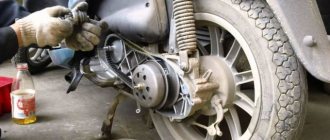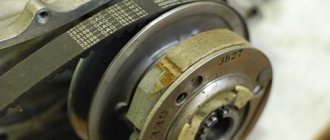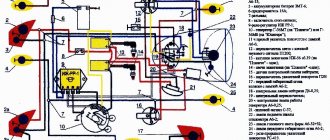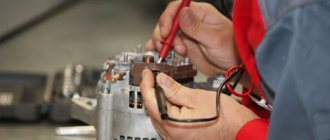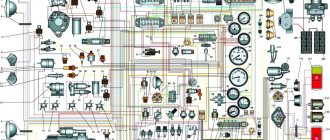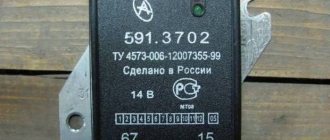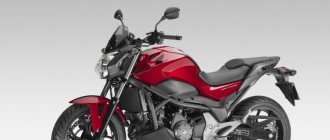- home
- Car electrics
- …
I have already talked about the generator overrunning clutch , that it really increases the service life of the belt drive. But the belts themselves have now become different; regular V-belts have been replaced by poly-V-belts, or as they are also called rivulet versions. Thanks to this, the connection of the crankshaft with various components has become much stronger, the service life has increased manifold, and the efficiency has also increased. However, in some catalogs, for some reason these two identical meanings are separated, that is, “poly” and “rivulet” are separate! Is this true, and what exactly is the difference, let’s figure it out...
To begin with, the definition
A rivulet (poly-V-ribbed) belt is a belt on the inner (working) side of which there are special “wedges” or, as they are now called, “rivulets”. They were created in order to improve the adhesion between pulleys of various units.
Nowadays they are widely used in cars to connect the crankshaft and attachments, such as a generator, power steering pump, air conditioning pump and others. The more complex the transmission, the more complex and wider the blade, as well as the number of “streams”.
When and how to change the V-belt.
The main problem in a car when the drive belts wear out at the initial stage are various creaks and whistles that occur during the rotation of the pulleys transmitting torque to the engine attachments. If these creaks and whistles occur, one of the drive belts may simply break soon. Dear friends and our readers, we offer you detailed information about the types of belts installed in modern cars. Our information directory will help you find out when it is necessary to change drive belts and also how to determine the degree of their wear, how a drive belt differs from a timing belt and what is the average cost of drive belts on the Russian market, and at the same time get for yourself and answers to other questions that interest you directly related to these belts.
First, let's immediately dot the i's and find out what they are - drive belts.
A car drive belt is an element of a belt drive, a specific working part of vehicles and mechanisms that serves to transmit engine torque.
The transmission of torque occurs due to frictional forces or engagement forces (timing belts, V-belts).
There is a misconception that the timing belt (timing belt drive) is not a drive belt. Actually this is not true. The timing belt also falls into the category of drive belts.
Drive belts are divided into several types, namely:
— Timing belt (timing belt drive).
— Drive belts for auxiliary components (engine attachments).
There are 3 (three) types of car belts:
1. Timing belt - as a rule, it is toothed.
2. Poly V-belt transmitting engine torque to engine attachments.
3. V-shaped (V-belt) transmission of engine torque to engine attachments.
Belts No. 2 and No. 3 in our country also have additional names, that is: flat belt (V-ribbed belt) or ripple belt (V-belt).
Unlike timing belts, which are subject to fairly strict requirements, such as mandatory timely scheduled replacement in accordance with the service life established by the manufacturer, drive belts that ensure the operation of engine auxiliary (attachment) equipment do not require such close attention.
But, nevertheless, this does not mean at all that they do not need our attention. They also periodically require scheduled replacement. Moreover, it is not advisable to wait until the belts fail, since these belts ensure the operation of important equipment in the car (cooling, battery charging, air conditioning, etc.).
Thus, if you suddenly hear a squeak or whistle under the hood of your car, we advise you to pay attention to it. Remember that extraneous noise under the hood is not only a nuisance for your hearing, but also something more. If a creaking or whistling noise appears under the hood of the car, this indicates that the drive belt is slipping on the pulleys. For example, if the belt is old, then its tension may be significantly weakened, which causes the belt to slip on the pulleys and produce a squealing noise while the engine is running.
Typically, when a belt is worn out or has loose tension, the slipping or squealing will only worsen in rainy and cold weather as the belt loses its grip on the pulley due to moisture.
If you, friends, heard a single squeak or whistle of a belt under the hood of your car, especially after driving through a deep puddle, then there is no particular reason to worry. In this case, the drive belt is most likely too wet, which has reduced its adhesion specifically to the pulley. If you hear this whistle (squeal) under the hood after starting the car in the morning or after several kilometers, or after starting to drive, or when the engine warms up, then most likely your drive belts (or belt) are worn out or weakened the tension of these drive belts itself.
pros
They have found their application not only in the automotive industry, in particular inside cars. But also in other areas, such as machine tools, drives and other complex connections. Why they became so widespread, let’s go point by point:
- High wear resistance
- Great resource
- Withstand high loads
- Less slippage
- You need to tighten and monitor them less often. In cars, there are generally tensioner rollers
- Smooth operation
- Can operate at high speeds
- Transmits high gear ratios
- Can be used in complex systems, as well as with the possibility of reverse bending
- Works in systems with non-parallel shafts
- Greater efficiency compared to the conventional “wedge” version
- Modern materials make them resistant not only to temperature changes, but also immune to atmospheric and ozone fluctuations.
The only negative points can be called cost and complexity in design. They cost two to three times more, but they take up to five times longer than regular options.
I’ll finish this, I think my information was useful to you. Sincerely yours, AUTOBLOGGER.
Similar news
- Engine chip tuning. Advantages and disadvantages. Is it worth doing at all? ...
- How does xenon work in a headlight? Let's disassemble its lamp and ignition unit
- The fuse is in the car. What is it for, how does it work and why...
Add a comment Cancel reply
Function of the drive belt (V-V and poly V-belt)
A V-shaped or poly-V belt is part of the engine drive belts, which serves as an auxiliary component that ensures the functionality of the attachments of the car’s power unit (water pump, air conditioning, generator, hydraulic booster).
The belt rotates due to the torque of the engine during operation. Torque is initially transmitted by the crankshaft of the engine itself. Next, the torque is transmitted through belts and pulleys to auxiliary equipment located under the hood.
For example, a V-belt has a V-shaped cross section, which allows the belt to transmit torque to the vehicle accessory pulleys. This type of belt drive is called V-belt torque transmission.
For example, this type of belt is often used to transmit engine torque to an electric generator that charges the battery.
The rotation of the generator produces electricity, which supports the operation of all electrical equipment in the vehicle.
Also, in many modern cars, this type of belt is also used to transmit torque to the electric power steering, to the cooling fan, to the water pump (coolant pump), to the air conditioning compressor and to the classic power steering wheel. Since this belt is subjected to enormous loads and constant temperature changes, it is made, as a rule, of hard rubber and a metal core, which provides strength and durability to the belt. Also, many belts have a durable textile thread, which allows the belt to withstand the transmission of high torque.
So, friends, remember, each car, in addition to the timing belt (some cars also use a timing chain), has one or more belt drives (depending on the technical features of the car), which ensure the functionality of engine attachments.
Structure
If you look at it from bottom to top, you will notice several layers:
- Protective layer . This is the top part (some call it the outer part). Made from polychloroprene (or neoprene, nayrite). This is a very durable component that holds the internal parts.
- Cord . Middle part. Made from durable threads, polyester or nylon. They are responsible for the power component
- Wedges, ribs, streams . Working part. They have a cross-sectional appearance, as many call it, in the form of a “saw” or several “mounds.” They are also made from polychloroprene, sometimes from chloroprene. Very durable and wear-resistant.
Why was polychloroprene or neoprene chosen as the main material in the structure? Keeping everything simple, it is very resistant to various kinds of influences, of which there are a lot in the operation of a belt drive (under the hood of a car). Resistant to open fire and high temperatures, excellent adhesion to fabrics and metals, high resistance to atmospheric changes, resistance to natural oxidation, abrasion and low temperatures. To put it simply, this is simply ideal material.
If the drive belt is cracked.. (consequences)
If the drive belt (or belts) in your car are worn out, they will have cracks and abrasions on their surface. Eventually, while the car is moving, a whistle will begin to appear. In this case, it should be clear that the time has come for their planned replacement. Remember, friends, that if you do not change the drive belt on time, you risk being left without working car equipment. For example, if a belt has reached the end of its service life due to severe wear and tear, it will naturally break sooner or later.
Typically, when the drive belt breaks, you will hear a loud bang from under the hood. As a result, the equipment receiving torque from it will cease to function. For example, if the drive belt that powers the generator breaks, it will simply stop charging the battery and powering all the electrical equipment of the car. As a result, you will see the battery icon light up on the car dashboard.
Also, if the belt breaks, the power steering will stop working. As a result, your steering wheel will become very difficult to turn. But the most important problem when the drive belt breaks is the lack of rotation transmission to the water pump, which promotes the circulation of coolant through the engine cooling system. As a result, the engine can quickly overheat. In this case, you must immediately stop driving, stop and turn off the engine.
Therefore, friends, while driving, constantly monitor the engine temperature sensor, which should show the same temperature of 90 degrees after the engine warms up. If you notice that the temperature needle on the device has gone up and is approaching the dangerous red zone, then in this case you need to stop, turn off the engine and diagnose the cooling system.
Attention! Overheating of the engine can lead to its premature failure (damage to valve stem seals, head gaskets, and also damage to the piston system). Therefore, friends, do not under any circumstances allow the power unit to overheat; monitor the engine temperature on the dashboard.
What determines the service life of drive belts?
Modern drive belts have a fairly long service life, all thanks to their design and modern reliable materials. On average, a high-quality belt can last up to 25 thousand hours of operation. Please note that the service life is indicated in hours, and not in kilometers, since the mileage itself does not directly affect the service life of the drive belts. After all, these belts are in motion even when the car is standing still and the engine is idling.
But this is in theory and according to information provided by the belt manufacturers themselves to consumers.
In practice, the service life of drive belts may differ significantly from that declared by the manufacturer. The point is that the wear of drive belts is influenced by many different factors. For example, the way it was installed on the car plays an important role in the long service life of belts. For example, it is not uncommon for car mechanics in technical centers, due to their low qualifications or lack of experience in car repairs, to try to fit a belt onto a pulley using a screwdriver. Ultimately, the new belt will become damaged and will no longer last as long as the manufacturer claims. This method of installing a drive belt is also used when it is necessary to speed up the process of replacing it, so as not to remove the pulley.
In addition, the service life of belts is also affected by the storage conditions of these components in the warehouse and during their transportation. For example, it is not uncommon for car dealerships to sell drive belts that have expired. Yes, drive belts certainly have an expiration date. The point here is this: the chemical composition of the materials of drive belts changes over time, and if the drive belt was produced 5 years ago and was incorrectly stored in a warehouse, then when installed on a car it will naturally not last very long.
Weather can also affect the durability of belts in a car. For example, if you live in a region with a hot climate, then you often use air conditioning. This means that the air conditioning compressor must then receive more of the required energy. As a result, this belt, which transmits torque to the air conditioning compressor, begins to experience increased load.
In particular, drive belts can quickly wear out if the machine is operated for a long time in cold and damp weather. For example, in winter, the electrical equipment of a car requires more power than in warm and dry weather.
As a result, the alternator requires more energy to maintain the electrical system in the vehicle. Ultimately, the alternator belt begins to experience increased stress due to increased torque.
As a rule, these drive belts last longer in a new car because they were installed at the factory and all the necessary storage conditions were observed before they were installed. Once the factory drive belts are replaced, the service life of the newly installed belts will be reduced.
Each car manufacturer in the technical documentation and in the car service book usually indicates in routine maintenance the date when it is necessary to regularly replace the drive belts. Therefore, we advise you, friends, to carefully read the list of scheduled technical inspections and the regulations for replacing consumables. As a rule, the manufacturer indicates the maximum mileage at which the drive belts must be replaced at a car mechanic's technical center. Thus, you will approximately know for yourself the maximum service life of drive belts. But this does not mean that you should not regularly inspect the condition of the belts. More on this below.
Ribbed (ribbed) belt. What it is? How to improve the generator's performance
I have already talked about the generator overrunning clutch, that it really increases the service life of the belt drive. But the belts themselves have now become different; regular V-belts have been replaced by poly-V-belts, or as they are also called rivulet versions. Thanks to this, the connection of the crankshaft with various components has become much stronger, the service life has increased manifold, and the efficiency has also increased. However, in some catalogs, for some reason these two identical meanings are separated, that is, “poly” and “rivulet” are separate! Is this true, and what exactly is the difference, let’s figure it out...
To begin with, the definition
A rivulet (poly-V-ribbed) belt is a belt on the inner (working) side of which there are special “wedges” or, as they are now called, “rivulets”. They were created in order to improve the adhesion between pulleys of various units.
Nowadays they are widely used in cars to connect the crankshaft and attachments, such as a generator, power steering pump, air conditioning pump and others. The more complex the transmission, the more complex and wider the blade, as well as the number of “streams”.
Structure
If you look at it from bottom to top, you will notice several layers:
- Protective layer. This is the top part (some call it the outer part). Made from polychloroprene (or neoprene, nayrite). This is a very durable component that holds the internal parts.
- Cord. Middle part. Made from durable threads, polyester or nylon. They are responsible for the power component
- Wedges, ribs, streams. Working part. They have a cross-sectional appearance, as many call it, in the form of a “saw” or several “mounds.” They are also made from polychloroprene, sometimes from chloroprene. Very durable and wear-resistant.
Why was polychloroprene or neoprene chosen as the main material in the structure? Keeping everything simple, it is very resistant to various kinds of influences, of which there are a lot in the operation of a belt drive (under the hood of a car). Resistant to open fire and high temperatures, excellent adhesion to fabrics and metals, high resistance to atmospheric changes, resistance to natural oxidation, abrasion and low temperatures. To put it simply, this is simply ideal material.
About “poly-wedges” (streams)
From the name it is clear that the inner surface (working) is made up of “wedges”, and the prefix “poly” means that there are many of them. The quantity depends on the pulleys of the attachment. On medium-sized foreign cars, where the generators do not have such massive pulleys (as, say, in business class), there are approximately 5 to 7 rivulets.
In cars of higher classes, it can reach up to 10, in trucks up to 12.
The more such wedges, the stronger the connection with the pulleys; accordingly, the load is distributed evenly and the service life increases.
By the way, many manufacturers and craftsmen call them “streams” because they look like parallel streams of water when viewed from below. BUT it is worth noting that these two names are the same! If they are listed separately in the catalog, then this is, to put it mildly, NOT CORRECT! The confusion may be due to the fact that different manufacturers call them differently. Let's say you look at the catalog for your car, one indicates a rivulet belt, and the other a poly belt, don't be afraid, they are the same, just the names are different.
V-belt or poly V-belt
AT the dawn of the appearance of cars, there was only one pulley for the generating plant, it was connected to the generator with one and very simple belt, which was made in the shape of a wedge - it was tall and cast. However, nylon threads were also used in the structure to strengthen the structure.
Such options did not last long, and very often they had to be tightened so that they did not slip. The side parts were subject to high wear and tear and it seemed to sag inward, then simply tore. YES, and the pulleys at that time had only one groove.
The service life of the wedge connection was very low, because the main load was on one link, there were frequent slippages (because there were no overrunning clutches) and, as a result, more wear. If such a connection is not tightened, it quickly wears out and breaks.
Later, poly-V-ribbed connections appear, and the pulleys of generators and other attached parts (in particular pumps) change. Now the internal belt drive belt already has several small wedges, it becomes WIDE and LOW, and on the hinged parts the pulleys also began to be made with several grooves.
Thus, by combining a wide belt drive and a wide pulley, we improve performance and reduce wear. Since we have much more engagement grooves.
By the way, here is a video on how to replace the old type with a new one, using the usual classics.
Whatever one may say, the usual wedge connection is becoming a thing of the past, now there will only be “poly” belt drives, they are simply more reliable, let’s talk about the advantages in more detail.
pros
They have found their application not only in the automotive industry, in particular inside cars. But also in other areas, such as machine tools, drives and other complex connections. Why they became so widespread, let’s go point by point:
- High wear resistance
- Great resource
- Withstand high loads
- Less slippage
- You need to tighten and monitor them less often. In cars, there are generally tensioner rollers
- Smooth operation
- Can operate at high speeds
- Transmits high gear ratios
- Can be used in complex systems, as well as with the possibility of reverse bending
- Works in systems with non-parallel shafts
- Greater efficiency compared to the conventional “wedge” version
- Modern materials make them resistant not only to temperature changes, but also immune to atmospheric and ozone fluctuations.
The only negative points can be called cost and complexity in design. They cost two to three times more, but they take up to five times longer than regular options.
I’ll finish this, I think my information was useful to you. Sincerely yours, AUTOBLOGGER.
Regularly checking drive belts
Periodically, every car owner should check the condition of all drive belts and their tension. To do this, check the belts with your finger while the engine is off. For example, by pressing your finger on the belt, you can understand for yourself whether the belt drive tension has loosened or not. Remember that the belt should not move during this inspection (move 1 - 2 cm). If you see something like this, then the cause is weak belt tension. You should also inspect the belt by touch for damage, and a visual inspection is also necessary for chips, cracks and torn elements on the belt.
To do this, use a flashlight, which will not only make your vision better, but can also help you identify worn areas on the belt (as a rule, worn areas of the belt will shine).
In any case, if you see damaged areas on the belt, then it must be replaced with a new one. Please note that when purchasing new drive belts you do not need to purchase original consumables. Today there are many non-original belts on the market, which are often even superior in quality to factory originals. For example, it has proven itself to be the largest supplier of drive belts.
The average cost of replacing a belt in a car repair shop is approximately 2,500 thousand rubles. The cost of car belts itself depends on the popularity of the brand and the cost of the product. There are both cheap drive belts on the market and expensive ones that have a special design and are able to withstand extreme loads.
Prices
Cost of poly V-belts:
- for AUDI cars - BOSCH belt - from 251 rubles;
- for Porsche cars - Contitech 3РК600 belt - from 255 rubles;
- for Ford cars - BOSCH belt - from 253 rubles;
- for Citroen - Skf belt - from 259 rubles;
- for Alfa Romeo - Bosch belt - from 250 rubles;
- for BMW - Skf - from 250 rubles;
- for Cadillac cars - Gates belt - from 825 rubles;
- for a Hummer car - Contitech belt - from RUB 2,701;
- for Jaguar - Dayco belt - from 305 rubles;
Then the list continues, approximately in the same price range - from 250 rubles for 2022. VAZ LADA, AUDI, BMW, Mercedes, cars from Korea or China, etc., do not require large investments to replace the belt. For Rolls-Royce, Bentley, Ferrari and other top world cars, accordingly, belts cannot be bought in ordinary car stores.
(2 ratings, average 4 out of 5)
How to tension, tighten or loosen a drive belt
If the cause of the whistle, squeal or squeak is actually a belt that has become loose and as a result slips on the pulleys, and if the belt does not have any signs of wear or damage, then to remove the extraneous sound you just need to tighten the belt.
Using the same example of a generator belt, this is done using a special adjusting bolt (on modern cars) or using an adjusting bar (on older cars).
For example, to tighten the alternator belt on a modern car, you need to do the following:
— Slightly loosen the generator mounting bolts (upper and lower fastenings).
— Turn the adjusting bolt clockwise, thereby moving the generator away from the engine block and immediately check the belt tension level.
— Then, tighten the nuts of the generator fastening elements.
Please note that in some vehicle systems, the process of tensioning the drive belts is too labor-intensive and requires the use of special tools.
Attention . New generation poly-V-ribbed elastic belts are currently widespread on the market, as well as in many cars. For example, one of the world's well-known manufacturers of such belts is currently. Their products have proven themselves to be the best today. This company is an official supplier for many car factories. Elastic poly V-belts do not require tensioning, tightening, etc. manipulation. Due to their design and material, such belts do not stretch. As a rule, such drive belts last a long time, approximately 120 thousand kilometers.
But for its (their) initial tension a special tool is needed.
In many cars, special belt tension rollers are also used for this, which saves drivers from constantly tightening these belts. The only drawback of this design, as a rule, is that when replacing drive belts, it is also necessary to change the tension roller itself, since its reuse together with a new belt is impossible.
see also
Comments 16
please tell me, are the two rollers of this belt the same? or are there differences? otherwise I plan to purchase a belt and rollers in advance (no replacement is required yet, it works without problems, but I want it to be in stock) and I was wondering if the rollers are different, and do I need to change the tensioner or just the roller that is on it?
Hello, yes the videos are the same. If the belt runs exactly in the center on the tensioner pulley, then the tensioner is fine. If it moves towards the wheel, it means it’s worn out.
Hi happy new year! the belt broke, drove less than 1000 5 streams, changed all the rollers, checked the pulleys. Now I only found Boshevsky 6 streams, how did your 6 go?
Hi happy new year! Once installed, everything spins!
Everything is simple and clear :) I was interested in this note.
Problem but more details.
There is no mention here of what will happen if you do it like I did. And in the link in the first message, people write that the factory installed 6-strand belts on 6-strand pulleys.
According to technotics, as far as I know, there should be one stream free. These engines have one problem: when the accessory belt delaminates, pieces of it fall under the timing belt pulley and tear it with the corresponding consequences, so there is at least some free flow, but there is insurance against this.
If the belt becomes frayed, then in any case it can get under the timing belt. A 4mm rope will not save you from such a situation, you need to watch it and use belts. Well, if there is a misalignment or some kind of pulley is chewing on the belt, then a 5-ribbed belt will not save you.
In no case is there a 6-stream one, there were 5 of them, this should have been installed, change it quickly.
I also thought about installing a 6-stream master at a service station, swore at me, then found it on the forum ( autoby.biz/forum/viewtopi…php?f=57&t=23670&start=45 “So, the engine with air conditioning is 2.0 16v F4R 746. Initially it was 5- The 6-groove Contitech 6 PK 1750 belt was installed after the maintenance. Result: a month of work and the belt was worn out, the grove on the belt closest to the engine was torn off by half the length of the belt, the engine stalled and would not start. At least I got to replace the belt...")
I read that the problem is different, they installed a 6-ribbed belt on the 5-ribbed crankshaft pulley. All my pulleys are original 6-groove, the belt is straight.
There were differences in the number of streams until 2000, after which there were only 5 streams.
I have a 2002, all 6 streams! And my brother has 2002, all 6 streams! It's not a matter of years!
I have five 2001, it came off the assembly line on December 12th.
I have a 2002, all 6 streams! And my brother has 2002, all 6 streams! It's not a matter of years!
Replacing drive belts at a technical center
Modern cars today are equipped with sophisticated technologies and new complex engines with additional equipment. Most modern vehicles have very, very little space under their hood. In some cars there is simply no free space under the hood. Therefore, replacing drive belts in new cars yourself is not so easy. After all, in order to replace drive belts, it is necessary to dismantle many attachments. And all this just to get to the belts themselves.
Typically, replacing drive belts along with rollers may take about 1.5 - 2 hours. The average cost of an hour in Russia is currently about 35 - 50 US dollars. Accordingly, the cost of replacing belts can range from approximately 2,500 to 9,000 thousand rubles (depending on the technical center, make and model of the car).
In older cars, the process of replacing drive belts usually lasts no more than half an hour, since due to the simpler design of the engine compartment, access to the rollers and belts is more convenient.
About “poly-wedges” (streams)
From the name it is clear that the inner surface (working) is made up of “wedges”, and the prefix “poly” means that there are many of them. The quantity depends on the pulleys of the attachment. On medium-sized foreign cars, where the generators do not have such massive pulleys (as, say, in business class), there are approximately 5 to 7 rivulets.
In cars of higher classes, it can reach up to 10, in trucks up to 12.
The more such wedges, the stronger the connection with the pulleys; accordingly, the load is distributed evenly and the service life increases.
By the way, many manufacturers and craftsmen call them “streams” because they look like parallel streams of water when viewed from below. BUT it is worth noting that these two names are the same! If they are listed separately in the catalog, then this is, to put it mildly, NOT CORRECT! The confusion may be due to the fact that different manufacturers call them differently. Let's say you look at the catalog for your car, one indicates a rivulet belt, and the other a poly belt, don't be afraid, they are the same, just the names are different.
How can I remove the whistling, squeaking or crackling sound coming from the belt under the hood?
Unfortunately for us, eliminating belt squeal by tightening does not always help. In this case, you need to replace the old belt with a new one. But many car owners prefer to delay this process itself for as long as possible. To do this, they purchase various sprays from auto stores that they spray on belts. As a result, to the surprise of many specialists and others, this helps.
But again, unfortunately, not for long. Some craftsmen even suggest using a screwdriver and a piece of soap to process the side surface of the belt while the engine is running. For our part, we categorically do not recommend doing this, since, on the one hand, it is very dangerous to carry out any work with rotating components while the engine is running, and on the other hand, the effect of such similar old-fashioned methods is short-lived.
DIN 7867
Poly V-belts with profiles: PH, PJ, PK, PL, RM correspond to this European standard. They are also used in:
- household appliances
- ventilators
- industrial washing machines
- agricultural machines
Let's start looking at the dimensions of each profile.
PH
The rubber products in question with the PH profile have a length from 1140 to 2404 mm, a height of 2.7 mm and a pitch of 1.6 mm.
| L | h | p |
| 1140 | 2,7 | 1,6 |
| 1219 | 2,7 | 1,6 |
| 1260 | 2,7 | 1,6 |
| 1580 | 2,7 | 1,6 |
| 1600 | 2,7 | 1,6 |
| 1653 | 2,7 | 1,6 |
| 1845 | 2,7 | 1,6 |
| 1874 | 2,7 | 1,6 |
| 1890 | 2,7 | 1,6 |
| 1915 | 2,7 | 1,6 |
| 1930 | 2,7 | 1,6 |
| 1951 | 2,7 | 1,6 |
| 1980 | 2,7 | 1,6 |
| 1992 | 2,7 | 1,6 |
| 2404 | 2,7 | 1,6 |
P.J.
This ribbed belt profile has a length from 356 to 2489 mm, a height of 4 mm and a pitch of 2.34 mm.
| L | h | p |
| 356 | 4 | 2,34 |
| 381 | 4 | 2,34 |
| 406 | 4 | 2,34 |
| 432 | 4 | 2,34 |
| 457 | 4 | 2,34 |
| 483 | 4 | 2,34 |
| 508 | 4 | 2,34 |
| 559 | 4 | 2,34 |
| 584 | 4 | 2,34 |
| 610 | 4 | 2,34 |
| 660 | 4 | 2,34 |
| 686 | 4 | 2,34 |
| 711 | 4 | 2,34 |
| 737 | 4 | 2,34 |
| 762 | 4 | 2,34 |
| 786 | 4 | 2,34 |
| 813 | 4 | 2,34 |
| 838 | 4 | 2,34 |
| 864 | 4 | 2,34 |
| 889 | 4 | 2,34 |
| 914 | 4 | 2,34 |
| 965 | 4 | 2,34 |
| 991 | 4 | 2,34 |
| 1016 | 4 | 2,34 |
| 1054 | 4 | 2,34 |
| 1092 | 4 | 2,34 |
| 1143 | 4 | 2,34 |
| 1168 | 4 | 2,34 |
| 1194 | 4 | 2,34 |
| 1219 | 4 | 2,34 |
| 1245 | 4 | 2,34 |
| 1270 | 4 | 2,34 |
| 1295 | 4 | 2,34 |
| 1321 | 4 | 2,34 |
| 1372 | 4 | 2,34 |
| 1397 | 4 | 2,34 |
| 1461 | 4 | 2,34 |
| 1473 | 4 | 2,34 |
| 1549 | 4 | 2,34 |
| 1600 | 4 | 2,34 |
| 1626 | 4 | 2,34 |
| 1651 | 4 | 2,34 |
| 1702 | 4 | 2,34 |
| 1753 | 4 | 2,34 |
| 1778 | 4 | 2,34 |
| 1854 | 4 | 2,34 |
| 1930 | 4 | 2,34 |
| 1956 | 4 | 2,34 |
| 1981 | 4 | 2,34 |
| 2019 | 4 | 2,34 |
| 2083 | 4 | 2,34 |
| 2210 | 4 | 2,34 |
| 2286 | 4 | 2,34 |
| 2337 | 4 | 2,34 |
| 2489 | 4 | 2,34 |
PK
A poly V-belt with this profile has a length from 527 to 2550 mm, a height of 5.4 mm and a pitch of 3.56 mm.
| L | h | p |
| 527 | 5,4 | 3,56 |
| 630 | 5,4 | 3,56 |
| 648 | 5,4 | 3,56 |
| 698 | 5,4 | 3,56 |
| 730 | 5,4 | 3,56 |
| 755 | 5,4 | 3,56 |
| 770 | 5,4 | 3,56 |
| 810 | 5,4 | 3,56 |
| 830 | 5,4 | 3,56 |
| 880 | 5,4 | 3,56 |
| 920 | 5,4 | 3,56 |
| 960 | 5,4 | 3,56 |
| 1000 | 5,4 | 3,56 |
| 1035 | 5,4 | 3,56 |
| 1130 | 5,4 | 3,56 |
| 1205 | 5,4 | 3,56 |
| 1280 | 5,4 | 3,56 |
| 1314 | 5,4 | 3,56 |
| 1397 | 5,4 | 3,56 |
| 1420 | 5,4 | 3,56 |
| 1460 | 5,4 | 3,56 |
| 1480 | 5,4 | 3,56 |
| 1520 | 5,4 | 3,56 |
| 1549 | 5,4 | 3,56 |
| 1610 | 5,4 | 3,56 |
| 1645 | 5,4 | 3,56 |
| 1725 | 5,4 | 3,56 |
| 1843 | 5,4 | 3,56 |
| 1885 | 5,4 | 3,56 |
| 1980 | 5,4 | 3,56 |
| 2031 | 5,4 | 3,56 |
| 2080 | 5,4 | 3,56 |
| 2164 | 5,4 | 3,56 |
| 2236 | 5,4 | 3,56 |
| 2550 | 5,4 | 3,56 |
P.L.
This rubber product with the above profile has a length from 991 to 6096 mm, a height of 9 mm and a pitch of 4.7 mm.
| L | h | p |
| 991 | 9 | 4,7 |
| 1041 | 9 | 4,7 |
| 1149 | 9 | 4,7 |
| 1168 | 9 | 4,7 |
| 1194 | 9 | 4,7 |
| 1219 | 9 | 4,7 |
| 1270 | 9 | 4,7 |
| 1295 | 9 | 4,7 |
| 1321 | 9 | 4,7 |
| 1334 | 9 | 4,7 |
| 1346 | 9 | 4,7 |
| 1372 | 9 | 4,7 |
| 1397 | 9 | 4,7 |
| 1422 | 9 | 4,7 |
| 1435 | 9 | 4,7 |
| 1473 | 9 | 4,7 |
| 1499 | 9 | 4,7 |
| 1562 | 9 | 4,7 |
| 1613 | 9 | 4,7 |
| 1651 | 9 | 4,7 |
| 1664 | 9 | 4,7 |
| 1715 | 9 | 4,7 |
| 1727 | 9 | 4,7 |
| 1765 | 9 | 4,7 |
| 1803 | 9 | 4,7 |
| 1841 | 9 | 4,7 |
| 1943 | 9 | 4,7 |
| 1956 | 9 | 4,7 |
| 1981 | 9 | 4,7 |
| 2019 | 9 | 4,7 |
| 2070 | 9 | 4,7 |
| 2096 | 9 | 4,7 |
| 2134 | 9 | 4,7 |
| 2197 | 9 | 4,7 |
| 2235 | 9 | 4,7 |
| 2324 | 9 | 4,7 |
| 2362 | 9 | 4,7 |
| 2477 | 9 | 4,7 |
| 2515 | 9 | 4,7 |
| 2705 | 9 | 4,7 |
| 2743 | 9 | 4,7 |
| 2845 | 9 | 4,7 |
| 2895 | 9 | 4,7 |
| 2921 | 9 | 4,7 |
| 2997 | 9 | 4,7 |
| 3085 | 9 | 4,7 |
| 3124 | 9 | 4,7 |
| 3289 | 9 | 4,7 |
| 3327 | 9 | 4,7 |
| 3492 | 9 | 4,7 |
| 3696 | 9 | 4,7 |
| 4051 | 9 | 4,7 |
| 4191 | 9 | 4,7 |
| 4470 | 9 | 4,7 |
| 4622 | 9 | 4,7 |
| 5029 | 9 | 4,7 |
| 5385 | 9 | 4,7 |
| 6096 | 9 | 4,7 |
RM
The PM profile has a length from 2286 to 16764 mm, a height of 14.2 mm and a pitch of 9.4 mm.
| L | h | p |
| 2286 | 14,2 | 9,4 |
| 2388 | 14,2 | 9,4 |
| 2515 | 14,2 | 9,4 |
| 2693 | 14,2 | 9,4 |
| 2832 | 14,2 | 9,4 |
| 2921 | 14,2 | 9,4 |
| 3010 | 14,2 | 9,4 |
| 3124 | 14,2 | 9,4 |
| 3327 | 14,2 | 9,4 |
| 3531 | 14,2 | 9,4 |
| 3734 | 14,2 | 9,4 |
| 4089 | 14,2 | 9,4 |
| 4191 | 14,2 | 9,4 |
| 4470 | 14,2 | 9,4 |
| 4648 | 14,2 | 9,4 |
| 5029 | 14,2 | 9,4 |
| 5410 | 14,2 | 9,4 |
| 6121 | 14,2 | 9,4 |
| 6883 | 14,2 | 9,4 |
| 7646 | 14,2 | 9,4 |
| 8408 | 14,2 | 9,4 |
| 9169 | 14,2 | 9,4 |
| 9931 | 14,2 | 9,4 |
| 10693 | 14,2 | 9,4 |
| 12217 | 14,2 | 9,4 |
| 13741 | 14,2 | 9,4 |
| 15266 | 14,2 | 9,4 |
| 16764 | 14,2 | 9,4 |
V-shaped - V-belt, poly-V-belt and toothed belt - what is the difference?
The drive belts of engine attachments should not be confused with timing belts, which synchronize the operation of the valves in the cylinder head with the piston system of the engine block using the camshaft.
As a rule, the timing belt is made of a completely different material from the drive belts of the same generator and other auxiliary equipment. Also, in some cars, the water pump drive is driven not by the V-belt or poly-V belt itself, but specifically by the timing belt, which, due to the special design of the engine, in addition to powering the water pump, also synchronizes the operation of the valves with the pistons.
The timing belt is made from a plastic composite material and has many special teeth that protect the belt from slipping. This is necessary so that the valves work synchronously with the piston system itself and do not collide with each other. After all, many of us motorists already understand that if the timing belt slips and the timing of the gas distribution mechanism goes wrong, the engine will not be able to work or will simply fail.
The timing belt also tends to stretch and has a maximum service life. This belt requires closer attention from the motorist, since if it wears out or breaks, the car’s engine can be seriously damaged and damaged, which will ultimately lead to huge financial costs.
Read more about this here.
